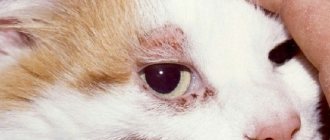There is an opinion that if a pet does not go outside, it cannot have worms. But veterinary practice confirms the presence of helminthiasis in 40% of domestic cats. This means that there are actually more ways of becoming infected with parasites.
Information about possible methods of infection with helminths will help prevent the development of diseases and even save the life of your pet.
Cat health
Veterinary medicine identifies a lot of diseases that cats often face. These include skin lesions (lichen), digestive disorders, problems with development and growth, exposure to various parasites and many others. Animals can develop helminths even if they are constantly at home and do not go outside.
Why do cats have worms and what causes their appearance? The presence of parasites can occur due to various factors that need to be carefully examined. This can prevent dangerous consequences in the future.
It is worth noting! Removal of worms from cats should be carried out immediately after the presence of these pathogenic parasites is detected. The animal’s body is not able to independently fight helminths and their larvae; its immune system does not produce antibodies to these pathogenic organisms.
The effect of helminths on the kitten’s body
Unfortunately, worms in kittens can cause serious complications. When helminths are in the baby’s body, they poison him with the products of their vital activity, thereby causing poisoning. Symptoms of intoxication may appear due to the disintegration of worms after death.
Worms, parasitizing various organs, mechanically disrupt their integrity. As a result, bleeding surfaces appear in the liver, lungs, and gall bladder, in which pathogenic microorganisms quickly develop.
Worms in kittens can lead to intestinal blockage, and sometimes this causes intestinal rupture. In addition, the baby’s body is not strong enough, due to the negative influence of parasites, his immunity decreases.
Routes of infection
The larvae of various helminths can be found almost everywhere - on the grass, in the ground, on plants. For this reason, you should not think that if a cat is constantly at home and does not walk outside, he will not be able to pick up worms. You can bring helminth eggs into your house from the street along with dirt on your shoes, or you can bring them on your clothes.
It is imperative to take into account other infectious causes that may be predisposing factors for helminth infection:
- parasites can appear when a cat eats cape or raw fish or tap water;
- the likelihood of a cat becoming infected with worms increases when fleas occur;
- contact with infected animals, with feces;
- Sometimes intrauterine infection of kittens from an infected cat occurs.
Find out whether you can get worms from a cat.
How to Prevent Tapeworms (and the Fleas That Cause Them)
Treating your cat of a flea infestation with flea and tick medication is the best defense against tapeworms. However, if an infestation does occur, it is necessary to treat the environment along with the cat to prevent re-infestations.
Because cats are finicky, you may not see the fleas they ingest or know they have tapeworms until an infestation occurs.
Ask your veterinarian which flea and tick preventatives are safe for your cat. Keep your cat indoors away from dead animals and trash to prevent tapeworms from ingesting them.
Symptoms of worms in cats
How can you tell if your cat has worms? Many pet owners cannot immediately determine the presence of helminths in their pets, but they, in turn, actively develop and cause serious discomfort to the cat.
To find out that pathogenic organisms have appeared in the animal’s body, you should first pay attention to the pet’s behavior. But often the signs of the presence of worms are similar to the symptoms of many infectious diseases.
Signs of worms in cats may include the following:
- Stool disorders - constipation, diarrhea;
- Frequent vomiting;
- Stool may take on a dark color;
- The pet may experience a sharp decrease in body weight;
- Mucus may be observed in the structure of the stool, and blood may also be present;
- Hair loss;
- Your pet may have difficulty breathing;
- Inhibition in the development of kittens;
- The pet constantly arrives in a lethargic and lethargic state; he may react poorly to others;
- Decreased or, conversely, increased appetite;
- The appearance of signs of cough;
- Bloating;
- Worms and larvae can be detected in the animal's feces, and parasites can also be found on the fur near the tail;
- In advanced forms of the disease, the cat may experience seizures;
- Pregnant cats may experience premature labor.
Symptoms of gastrointestinal tract damage
First of all, with helminthic infestations, digestion suffers. This manifests itself in different ways:
- constipation and/or diarrhea;
- bloating of the abdomen, which becomes unusually dense to the touch;
- loss of appetite;
- sudden weight loss;
- gagging (often immediately after eating).
If at least one of these signs appears, the owner must take the cat to the veterinarian to exclude or confirm the presence of helminthic infestation and other dangerous pathologies.
Types of worms in cats
Cats can have different types of worms, which can be accompanied by different symptoms. It is worth carefully considering the characteristics of parasites, their manifestations and routes of infection.
Tapeworms (cestodes)
These are long and flat worms that can reach a length of up to 70 centimeters. The body of the parasite has a large number of segments, in each of which a larva matures.
After the larvae fully mature, they come out together with the feces. And the segmented body of the parasitic organism continues to grow further, new segments with larvae grow to replace the separated ones. And this process happens again and again without interruption.
Infection with this type of worms in cats can occur through consumption of raw meat or fish. Stray animals can become infected with worms when they eat mice, rats, or rodents. Sometimes fleas carry parasites.
The main signs of cestode infection in animals include the following:
- change in body weight - the cat can suddenly lose weight or, on the contrary, gain weight;
- decreased or increased appetite;
- bloating;
- hair loss;
- increased licking in the anal area.
Roundworms
Roundworms are considered the most common helminths in cats. This species includes a large number of parasitic organisms, but roundworms are considered the most common. They look like spaghetti, which is why they are called “round”. The average length of roundworms can be 5 cm, but longer parasites are sometimes found.
The causes of infection include the following:
- eating raw meat and fish;
- contact with an infected animal, feces with helminths, sand, soil, which contain larvae and parasites;
- kittens can become infected with parasites through their mother's milk.
Note! Roundworms, namely roundworms, usually accumulate in the area of the small intestine. They severely injure the mucous layer of the stomach, and they also clog the bile ducts and intestines. They parasitize almost all internal organs and have a strong toxic effect on the animal’s body.
Symptoms of roundworm infection include the following:
- weight loss;
- diarrhea;
- the appearance of anemia;
- the occurrence of rashes and wounds on the surface of the skin, these signs are especially often observed on the paws. These are traces of the movement of helminths;
- severe darkening of the stool, sometimes there may be blood in it.
Anti-worm medications for kittens
There are many medications for worms. Each pharmacy is ready to offer a wide range of various drops, suspensions, tablets and vaccines to treat your pet. But when treating a kitten, you need to be very careful in choosing means to combat helminths.
Behind the various commercial names of drugs lies a certain set of chemicals, the effects of which can be dangerous for a small organism. It is important to give medications appropriate to the kitten's age. It is better to choose time-tested drugs.
The classic deworming remedy contains two main components that affect:
- round parasites (active ingredients pyrantel, fenbendazole, piperazine or milbemycin);
- tapeworms (active ingredient praziquantel).
The most well-known products, identified by release form:
| Pills | Suspension | Drops |
| Pratel Febtal Trontsil K Milbemax | Prazitsid-plus Dirofen-paste | Profender Stronghold |
The most common release option is tablets. For the smallest kittens, Prazicide-plus, produced in the form of a sweet suspension, is best suited. This medicine is considered the safest and is suitable for kittens from 3 weeks of age.
Important! Do not give deworming medications to your kitten yourself. For safe treatment, consultation with a veterinarian is required. Only a doctor will be able to determine possible kidney and liver diseases, the weight category of the kitten and assess the general condition of the animal in order to safely prescribe medication.
Diagnostic features
Only a veterinarian can establish or refute the final diagnosis. During diagnosis, an analysis for enterobiasis is carried out; for this, feces or blood of the animal can be taken. If worm eggs are found in stool tests, the veterinarian will determine that the animal actually has parasites.
Interesting! Sometimes a kitten becomes infected with worms, but the mother's stool test for helminths may be negative. In this case, the parasites could enter the body through mother's milk.
DYPHYLLOBOTRIOSIS
Diphyllobothrium latum – wide tapeworm. This is the largest cestode that parasitizes humans and carnivores. The length of an adult is from 50 cm to 10 m, in rare cases reaches 20 m, the body width is 0.5-1.5 cm. Strobila has up to 4000 proglottids. The scolex is small with two slit-like bothria. The egg contains an embryo - a coracidium with six chitinous hooks. The lifespan of a wide tapeworm in the body can reach 20 years or more.
Routes of infection
- Eating raw fish infected with tapeworm plerocercoids.
Life cycle
The definitive host excretes immature tapeworm eggs in feces. For further development, the eggs must be placed in water. Under favorable conditions, after 2-3 weeks, larvae with 3 pairs of hooks - coracidia - appear in them. The coracidia emerge from the egg and float freely in the water. They are swallowed by the first intermediate host ( yellow crustaceans
).
In their intestines, the coracidium darts, turns into an oncosphere and penetrates into the body cavity of the crustacean, where after 2-3 weeks a larva, a procercoid, develops from it. The second intermediate host - planktonic fish
or
fry of predatory fish
- become infected by eating crustaceans.
In the body of fish, the procercoid penetrates the muscles and internal organs and turns into a form that is invasive for the definitive host - the plerocercoid. The definitive host becomes infected by eating raw fish
. The plerocercoid is attached by bothria to the wall of the initial part of the small intestine, after 14-30 days it reaches the stage of a sexually mature individual and begins to secrete eggs.
Definitive owner
– humans, carnivores (dogs, cats, foxes, arctic foxes, wolves), fish-eating birds.
Intermediate host
– I-cyclops and diaptomus, II-pike, perch, burbot, ruff, etc.
A person becomes infected with diphyllobothriasis by eating poorly thermally processed river fish.
Symptoms
For diphyllobothriasis, the symptoms are nonspecific. Depression of general condition, loss of appetite, deterioration in coat quality.
How to treat worms in cats
Treatment of a cat for worms is prescribed only by a doctor, after an accurate diagnosis has been established. The veterinarian must determine the type of parasites, and then prescribe special anthelmintic drugs.
Antihelminthic treatment should be aimed at:
- destruction and removal of parasitic helminths from the cat’s body;
- relief of associated symptoms;
- elimination of poisoning of the animal's body.
Worth considering! There are anti-helminth medications that act on a specific type of helminth, and there are complex broad-spectrum medications that contain several types of components that act on different types of helminths.
Use of tablets
You can remove worms from a cat using anthelmintic drugs in tablet form. They are able to remove almost any type of parasite. But they should be used in accordance with the instructions.
Before treating worms with tablets, you should consult a veterinarian. The fact is that many medications in tablet form have contraindications and side symptoms.
Effective tablets against worms in cats include the following drugs:
- Kanikquantel plus . This medicine has an effect on helminths. When taken, the active components cause blocking of the neuromuscular system in worms;
- Envyer . The constituent elements cause paralysis in parasites;
- Drontal . Has a damaging effect on the muscles of parasitic organisms, causing paralysis and subsequent death;
- Milbemax . This is a deworming medicine for cats that helps eliminate parasites from the digestive tract area;
- Pratel . This is an effective remedy that removes roundworms and tapeworms, causing paralysis in them.
Find out more about the types of deworming tablets for cats and how to use them.
Drops on the withers
Anti-worm drops for cats can be used in cases where the animal refuses to take the drug orally. This form of medication can be used to treat your pet’s withers.
Effective anthelmintic medications include the following deworming drops for cats:
- Profender . This effective remedy can be used if there is toxocariasis, hookworm disease, depilidosis, diphyllobothriasis in cats and other helminthic diseases;
- Stronghold for cats . This is an effective anti-worm remedy that is easy to use. Does not have a harmful effect on the animal’s body;
- Prazicide complex . Drops can be used to eliminate worms in cats. When used, it does not cause unpleasant symptoms and is well tolerated by animals. Should not be used on cats during nursing or pregnancy;
- Bars spot-on . When used, the active elements of the medicine penetrate into the blood. Maintains its effect for several weeks.
Suspensions
What else can you do if your cat has worms? Veterinarians may recommend deworming medications in the form of suspensions that can even be used on kittens. But before you give the suspension to your cat, you should carefully study the instructions for use.
Effective anthelmintic drugs in the form of suspensions include the following:
- Prazicide . An effective anti-worm suspension for cats that helps quickly remove parasites. It can be used for adult animals and kittens;
- Prazitel . An effective suspension that has a complex effect. When taking the drug, rapid elimination of parasites from the body is observed;
- Pyrantel . The active components of the drug have a blocking effect on the neuromuscular conduction of parasitic organisms. But the drug has no effect on larvae that are in the stage of movement.
Find out also other methods and approaches to treating worms in cats.
White flatworms: parasitic cestodes
In cats, white flatworms are less common, but it does happen. Cestodes (that is, flat parasitic worms) in some respects are seriously different from their “round” colleagues, both in body structure and physiological characteristics:
- The body of flatworms consists of many segments , each of which is a real container tightly packed with ripening eggs. Closer to the end of the body (and in cestodes it can reach several meters) there are segments with already matured eggs. Every day, thousands and hundreds of thousands of potential parasites are released into the external environment in the feces of a sick cat.
- The worm grows from the head. Thus, if due to some unfavorable (for the worm) factors it loses its entire body, the head, if it remains intact, will quickly grow a new one. And this is a big problem in treatment. If to remove roundworms it is enough to use drugs that simply stun the worms and promote their natural removal from the body, then with cestodiasis it is necessary to use “serious”, poisonous drugs that kill the worm “outright”. True, the body of the animal itself also has a hard time.
- Unlike roundworms, flatworms switched to a parasitic lifestyle a very long time ago, and therefore their body, in fact, is a combination of two systems: the reproductive (most species are bisexual) and the “digestive.” The name of the latter is in quotation marks because the body of these parasites only absorbs nutrients over the entire surface.
- An unpleasant feature of cestodes is the way they are secured in the intestines. As a rule, parasites use peculiar hooks for this purpose, and in more rare cases, suction cups. The problem is that the strength of this attachment is so good that sometimes the remains of the worm are removed surgically!
Routes of infection
As for the routes of infection, in the case of cestodes there is only one – nutritional. Parasites enter the cat's body through food or water. The clinical picture with cestodiasis is approximately the same as in the case of infection with roundworms; there are no striking features.
Note that the body of parasitic worms secretes much more toxins than if compared with roundworms, and therefore with parasitic cestodias the likelihood of severe intoxication is much higher.
It leads to a severe deterioration in the condition of the skin and coat; in these situations, the exhaustion of the animal is more pronounced.
Development cycle
In cestodes it is much simpler. The larvae of these worms do not mature in the lungs. It is enough for them (in the form of an egg or in the body of an intermediate host) to enter the cat’s digestive system, after which their rapid growth begins. As a rule, about a month passes from the moment a larva enters a cat’s gastrointestinal tract until the first eggs appear in its feces, but much depends on the condition of the animal, the time of year, and other factors.
Folk remedies
Folk remedies for worms in cats will also help rid your cat of worms. They are quite simple and affordable. The most effective include the following:
- A garlic enema will help remove worms from your cat at home. To prepare it you will need 6 cloves of garlic, which need to be cut into small pieces. Next, the garlic is poured into a glass of water and infused for two hours. Then you can give the animal an enema. However, with this method you need to be very careful, as a burn to the intestines is possible;
- fresh carrot enema. You need to squeeze about 20 ml of juice from the root vegetable and do an enema;
- a decoction of herbs - tansy flowers, peppermint, buckthorn bark, wormwood. You need to pour 2 large spoons of herbal mixture into a container and pour a glass of hot water. The prepared decoction must be given to the pet in the morning for three days.
Useful video
How to rid a kitten of worms:
Before starting treatment, be sure to take your kitten to see a veterinarian. The specialist will examine the animal, determine the degree of infection or prescribe medication for preventive purposes if the animal is healthy. The type of drug and dosage will depend on the age of the kitten and its general condition at the time of administration by the veterinarian.
If you have the slightest suspicion that your pet has worms, do not delay a visit to the veterinarian. The further course of the disease and the severity of possible consequences for the pet’s fragile body will depend on timely assistance.











